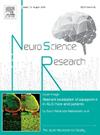Brain imaging and electrophysiological markers of anaphoric reference during speech production
IF 2.4
4区 医学
Q3 NEUROSCIENCES
引用次数: 0
Abstract
Pronouns create cohesive links in discourse by referring to previously mentioned elements. Here, we focus on pronominalization during speech production in three experiments employing ERP and fMRI methodologies. Participants were asked to produce two short sentences describing a man or woman using an object. In the second sentence, they were instructed to use a pronoun to refer to the same person and a noun to refer to a different person. The first ERP experiment revealed that noun conditions elicited more negative ERPs starting at 220 ms, with significant differences in early and later time windows, particularly in the left hemisphere. The second ERP experiment showed divergence at 280 ms, with significant differences between 300 and 400 ms at midline electrodes, again indicating more negative ERPs for nouns. The fMRI experiment identified greater activations for nouns than pronouns in regions like the superior temporal gyrus (STG) and cerebellar vermis, suggesting higher working memory load and lexical retrieval demands for nouns compared to pronouns. Moreover, pronouns elicited an enhanced centro-parietal positivity, indicating increased attentional demands. These findings suggest that while noun processing requires greater working memory and lexical retrieval, pronoun processing engages more attentional resources. This study advances our understanding of the neural mechanisms underlying pronominalization during speech production, highlighting distinct neural responses for nouns and pronouns.
言语生成过程中回指参照的脑成像和电生理标记。
代词通过引用前面提到的元素在语篇中形成衔接。本文采用ERP和功能磁共振成像(fMRI)方法,对语音生成过程中的发音现象进行了研究。参与者被要求用两个简短的句子来描述一个男人或女人使用一个物体。在第二句中,他们被要求用一个代词指代同一个人,用一个名词指代不同的人。第一个ERP实验显示,名词条件在220毫秒开始引发更多的负性ERP,在早期和后期的时间窗口有显著差异,尤其是在左半球。第二次ERP实验在280 ms出现分化,中线电极在300-400 ms之间存在显著差异,再次表明名词的负ERP更多。fMRI实验发现,与代词相比,名词在颞上回(STG)和小脑蚓部等区域的激活程度更高,这表明与代词相比,名词的工作记忆负荷和词汇检索需求更高。此外,代词引起了增强的中央-顶叶积极性,表明注意力需求增加。这些发现表明,名词加工需要更多的工作记忆和词汇检索,而代词加工则需要更多的注意力资源。本研究促进了我们对语音产生过程中代词化的神经机制的理解,突出了名词和代词的不同神经反应。
本文章由计算机程序翻译,如有差异,请以英文原文为准。
求助全文
约1分钟内获得全文
求助全文
来源期刊

Neuroscience Research
医学-神经科学
CiteScore
5.60
自引率
3.40%
发文量
136
审稿时长
28 days
期刊介绍:
The international journal publishing original full-length research articles, short communications, technical notes, and reviews on all aspects of neuroscience
Neuroscience Research is an international journal for high quality articles in all branches of neuroscience, from the molecular to the behavioral levels. The journal is published in collaboration with the Japan Neuroscience Society and is open to all contributors in the world.
 求助内容:
求助内容: 应助结果提醒方式:
应助结果提醒方式:


